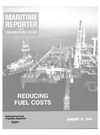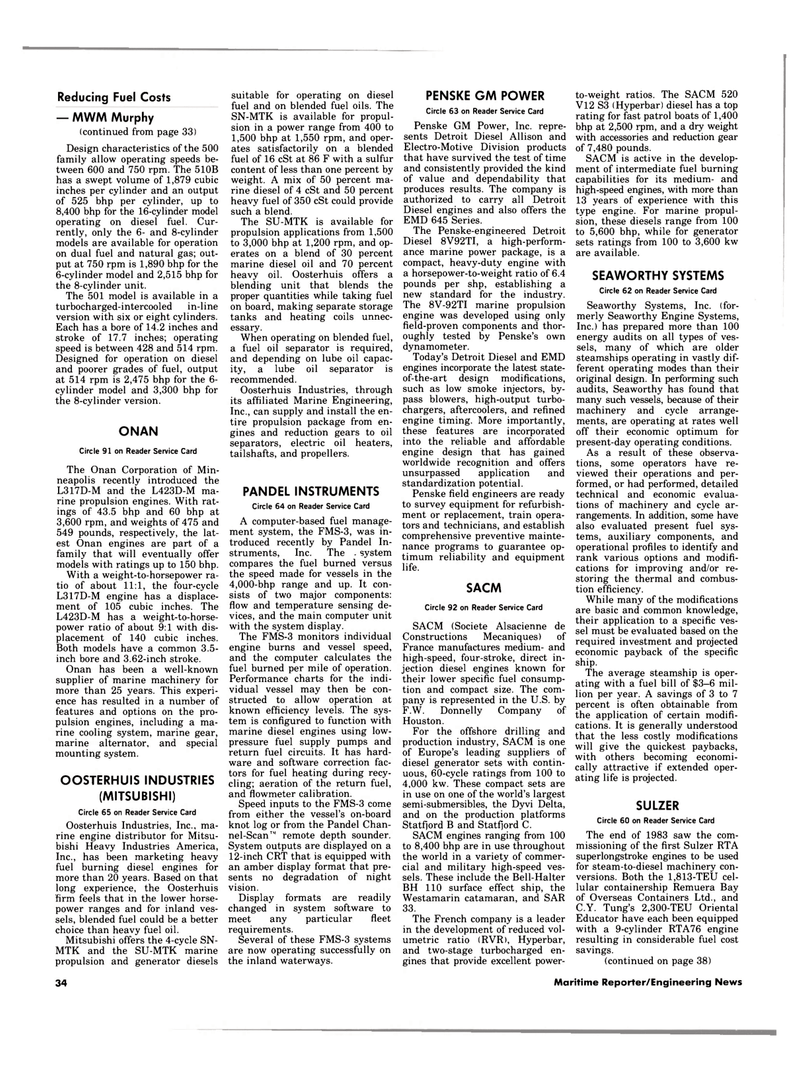
Page 32: of Maritime Reporter Magazine (January 15, 1984)
Read this page in Pdf, Flash or Html5 edition of January 15, 1984 Maritime Reporter Magazine
Reducing Fuel Costs — MWM Murphy (continued from page 33)
Design characteristics of the 500 family allow operating speeds be- tween 600 and 750 rpm. The 510B has a swept volume of 1,879 cubic inches per cylinder and an output of 525 bhp per cylinder, up to 8,400 bhp for the 16-cylinder model operating on diesel fuel. Cur- rently, only the 6- and 8-cylinder models are available for operation on dual fuel and natural gas; out- put at 750 rpm is 1,890 bhp for the 6-cylinder model and 2,515 bhp for the 8-cylinder unit.
The 501 model is available in a turbocharged-intercooled in-line version with six or eight cylinders.
Each has a bore of 14.2 inches and stroke of 17.7 inches; operating speed is between 428 and 514 rpm.
Designed for operation on diesel and poorer grades of fuel, output at 514 rpm is 2,475 bhp for the 6- cylinder model and 3,300 bhp for the 8-cylinder version.
ONAN
Circle 91 on Reader Service Card
The Onan Corporation of Min- neapolis recently introduced the
L317D-M and the L423D-M ma- rine propulsion engines. With rat- ings of 43.5 bhp and 60 bhp at 3,600 rpm, and weights of 475 and 549 pounds, respectively, the lat- est Onan engines are part of a family that will eventually offer models with ratings up to 150 bhp.
With a weight-to-horsepower ra- tio of about 11:1, the four-cycle
L317D-M engine has a displace- ment of 105 cubic inches. The
L423D-M has a weight-to-horse- power ratio of about 9:1 with dis- placement of 140 cubic inches.
Both models have a common 3.5- inch bore and 3.62-inch stroke.
Onan has been a well-known supplier of marine machinery for more than 25 years. This experi- ence has resulted in a number of features and options on the pro- pulsion engines, including a ma- rine cooling system, marine gear, marine alternator, and special mounting system.
OOSTERHUIS INDUSTRIES (MITSUBISHI)
Circle 65 on Reader Service Card
Oosterhuis Industries, Inc., ma- rine engine distributor for Mitsu- bishi Heavy Industries America,
Inc., has been marketing heavy fuel burning diesel engines for more than 20 years. Based on that long experience, the Oosterhuis firm feels that in the lower horse- power ranges and for inland ves- sels, blended fuel could be a better choice than heavy fuel oil.
Mitsubishi offers the 4-cycle SN-
MTK and the SU-MTK marine propulsion and generator diesels suitable for operating on diesel fuel and on blended fuel oils. The
SN-MTK is available for propul- sion in a power range from 400 to 1,500 bhp at 1,550 rpm, and oper- ates satisfactorily on a blended fuel of 16 cSt at 86 F with a sulfur content of less than one percent by weight. A mix of 50 percent ma- rine diesel of 4 cSt and 50 percent heavy fuel of 350 cSt could provide such a blend.
The SU-MTK is available for propulsion applications from 1,500 to 3,000 bhp at 1,200 rpm, and op- erates on a blend of 30 percent marine diesel oil and 70 percent heavy oil. Oosterhuis offers a blending unit that blends the proper quantities while taking fuel on board, making separate storage tanks and heating coils unnec- essary.
When operating on blended fuel, a fuel oil separator is required, and depending on lube oil capac- ity, a lube oil separator is recommended.
Oosterhuis Industries, through its affiliated Marine Engineering,
Inc., can supply and install the en- tire propulsion package from en- gines and reduction gears to oil separators, electric oil heaters, tailshafts, and propellers.
PANDEL INSTRUMENTS
Circle 64 on Reader Service Card
A computer-based fuel manage- ment system, the FMS-3, was in- troduced recently by Pandel In- struments, Inc. The . system compares the fuel burned versus the speed made for vessels in the 4,000-bhp range and up. It con- sists of two major components: flow and temperature sensing de- vices, and the main computer unit with the system display.
The FMS-3 monitors individual engine burns and vessel speed, and the computer calculates the fuel burned per mile of operation.
Performance charts for the indi- vidual vessel may then be con- structed to allow operation at known efficiency levels. The sys- tem is configured to function with marine diesel engines using low- pressure fuel supply pumps and return fuel circuits. It has hard- ware and software correction fac- tors for fuel heating during recy- cling; aeration of the return fuel, and flowmeter calibration.
Speed inputs to the FMS-3 come from either the vessel's on-board knot log or from the Pandel Chan- nel-Scan"' remote depth sounder.
System outputs are displayed on a 12-inch CRT that is equipped with an amber display format that pre- sents no degradation of night vision.
Display formats are readily changed in system software to meet any particular fleet requirements.
Several of these FMS-3 systems are now operating successfully on the inland waterways.
PENSKE GM POWER
Circle 63 on Reader Service Card
Penske GM Power, Inc. repre- sents Detroit Diesel Allison and
Electro-Motive Division products that have survived the test of time and consistently provided the kind of value and dependability that produces results. The company is authorized to carry all Detroit
Diesel engines and also offers the
EMD 645 Series.
The Penske-engineered Detroit
Diesel 8V92TI, a high-perform- ance marine power package, is a compact, heavy-duty engine with a horsepower-to-weight ratio of 6.4 pounds per shp, establishing a new standard for the industry.
The 8V-92TI marine propulsion engine was developed using only field-proven components and thor- oughly tested by Penske's own dynamometer.
Today's Detroit Diesel and EMD engines incorporate the latest state- of-the-art design modifications, such as low smoke injectors, by- pass blowers, high-output turbo- chargers, aftercoolers, and refined engine timing. More importantly, these features are incorporated into the reliable and affordable engine design that has gained worldwide recognition and offers unsurpassed application and standardization potential.
Penske field engineers are ready to survey equipment for refurbish- ment or replacement, train opera- tors and technicians, and establish comprehensive preventive mainte- nance programs to guarantee op- timum reliability and equipment life.
SACM
Circle 92 on Reader Service Card
SACM (Societe Alsacienne de
Constructions Mecaniques) of
France manufactures medium- and high-speed, four-stroke, direct in- jection diesel engines known for their lower specific fuel consump- tion and compact size. The com- pany is represented in the U.S. by
F.W. Donnelly Company of
Houston.
For the offshore drilling and production industry, SACM is one of Europe's leading suppliers of diesel generator sets with contin- uous, 60-cycle ratings from 100 to 4,000 kw. These compact sets are in use on one of the world's largest semi-submersibles, the Dyvi Delta, and on the production platforms
Statfjord B and Statfjord C.
SACM engines ranging from 100 to 8,400 bhp are in use throughout the world in a variety of commer- cial and military high-speed ves- sels. These include the Bell-Halter
BH 110 surface effect ship, the
Westamarin catamaran, and SAR 33.
The French company is a leader in the development of reduced vol- umetric ratio (RVR), Hyperbar, and two-stage turbocharged en- gines that provide excellent power- to-weight ratios. The SACM 520
V12 S3 (Hyperbar) diesel has a top rating for fast patrol boats of 1,400 bhp at 2,500 rpm, and a dry weight with accessories and reduction gear of 7,480 pounds.
SACM is active in the develop- ment of intermediate fuel burning capabilities for its medium- and high-speed engines, with more than 13 years of experience with this type engine. For marine propul- sion, these diesels range from 100 to 5,600 bhp, while for generator sets ratings from 100 to 3,600 kw are available.
SEAWORTHY SYSTEMS
Circle 62 on Reader Service Card
Seaworthy Systems, Inc. (for- merly Seaworthy Engine Systems,
Inc.) has prepared more than 100 energy audits on all types of ves- sels, many of which are older steamships operating in vastly dif- ferent operating modes than their original design. In performing such audits, Seaworthy has found that many such vessels, because of their machinery and cycle arrange- ments, are operating at rates well off their economic optimum for present-day operating conditions.
As a result of these observa- tions, some operators have re- viewed their operations and per- formed, or had performed, detailed technical and economic evalua- tions of machinery and cycle ar- rangements. In addition, some have also evaluated present fuel sys- tems, auxiliary components, and operational profiles to identify and rank various options and modifi- cations for improving and/or re- storing the thermal and combus- tion efficiency.
While many of the modifications are basic and common knowledge, their application to a specific ves- sel must be evaluated based on the required investment and projected economic payback of the specific ship.
The average steamship is oper- ating with a fuel bill of $3-6 mil- lion per year. A savings of 3 to 7 percent is often obtainable from the application of certain modifi- cations. It is generally understood that the less costly modifications will give the quickest paybacks, with others becoming economi- cally attractive if extended oper- ating life is projected.
SULZER
Circle 60 on Reader Sen/ice Card
The end of 1983 saw the com- missioning of the first Sulzer RTA superlongstroke engines to be used for steam-to-diesel machinery con- versions. Both the 1,813-TEU cel- lular containership Remuera Bay of Overseas Containers Ltd., and
C.Y. Tung's 2,300-TEU Oriental
Educator have each been equipped with a 9-cylinder RTA76 engine resulting in considerable fuel cost savings. (continued on page 38) 34 Maritime Reporter/Engineering News

 31
31

 33
33
